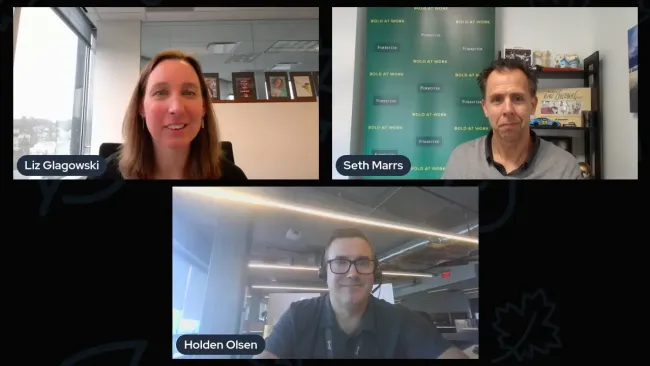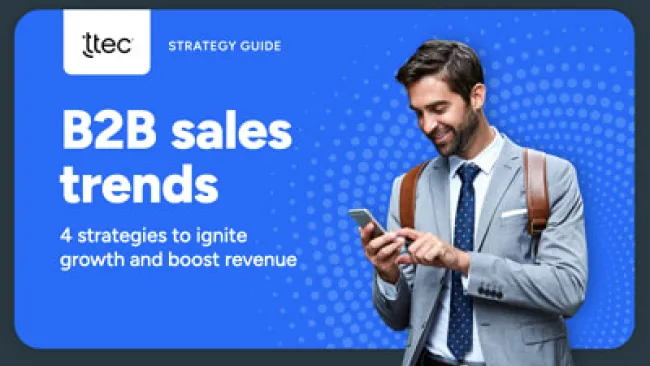The customer experience is often used in reference to customer service or marketing. Yet a superior customer experience can also greatly impact the sales world, as well. Both understanding the needs of your customer and developing a personal relationship with potential clients are critical in today’s crowded tech vendor landscape.
Because so many companies offer similar solutions and features, the customer experience becomes an important differentiating factor. Salespeople are at the front lines of developing those client relationships and need the right tools and skills to be successful. We’ve identified five factors that every sales leader should be mindful of:
1. It’s all about the customer.
Your solutions may be great, but you want to get into the mindset of your customer. You need to speak in their language, using their terms and solving their business problems. Sales executives who focus on their own products and use the language of their own company will struggle to find success. You’ve lost the customer the minute you spend more time speaking about your company’s capabilities rather than how to help your client solve his or her business needs.
Taking the time to truly understand the business of your customer and get a deeper understanding of the problems he or she is trying to solve is critical to developing the right experience and establishing the trust necessary for the client to choose to work with you. Every customer is unique. You must treat them, and the problems they face, differently to be successful. Seek first to understand their needs, which drive their behaviors, and ultimately you will understand what will deliver the most value. The worst place you can be as a sales executive is having no understanding of the prospective customer, relying on a generic sales approach to their problem. Remember a simple fact: to motivate a behavioral change, you must have insight into a customer’s true needs.
2. Use tools to help you be a fly on the wall.
Search engine optimization (SEO) and search engine marketing (SEM) are great for gathering information. Analyze user statistics for your websites, and where various inquiries have already taken place. How long have viewers hovered over your solution sets? Which white papers did they download? You can leverage many digital tools to help you narrow the list of people who have looked at your content and have needs that you can help them address.
The social media space is another great source of information. What are people commenting on in LinkedIn? Are there social media gatherings or conversations that you can participate in? Analyst reports from places like Gartner and Forrester Research are great for getting insights into what potential clients are looking for.
3. Ask questions.
Good sales executives do their homework before stepping into a customer’s office. Walk the hallways, talk to people in the customer’s area and outside in the competitive arena. As you align your solutions to a business need, figure out if there’s a good match. Is there a sense of urgency? What are the consequences if they don’t use the solution and what is the payback if they do? Well prepared sales executives are successful sales executives.
Sometimes you don’t have time to do research, such as when you are at a conference or in impromptu meetings with your clients. When that happens, ask questions to better understand your prospective clients. Don’t try to sell, or default to simple relationship-building conversations. Share best practices and stories as you learn more about the person’s needs, complaints, inquiries, and areas of interest. Really work to understand the areas of concern and business needs of your customer. Listen more than you talk.
As you learn what the business drivers and critical success factors are, you’ll begin to get a feel for the needs and prioritization of the customer’s various projects and initiatives. Combine that information with public information about the company, such as trends and revenue, to pinpoint areas that the company may be struggling with, and where you can make the biggest impact on their success. Before you walk into any client meeting, be well versed with your clients’ social style, and how you can work with them to reach a successful outcome. Understand who they have worked with in the past, and which external and internal solutions they’ve already used to help you gain insights into the best way to tailor your approach to providing the right solutions.
4. Build a sales organization based on trust.
Compensation and commissions are time-tested and proven as strong motivators for card carrying members of a quota club. However, a good sales executive also feels a sense of accomplishment from forming new client relationships that are sustainable over time. This happens when trust is established. They have established a relationship that is reliable, relevant, provides real value, and thus has earned trust over time.
As you lead and develop sales organizations, there are many tools to help sales executives earn trust, and achieve the results you need to grow your enterprise. Technology is clearly driving the increased speed, volume, and ubiquity of interactions with clients. Being competent, thinking about your client’s long-term interests, sharing best practices, and doing so with a human touch that is tied to their social style will drive sustainable results.
Ultimately, a really simple tool in leading and motivating sales organizations is to remind the teams that creating that client trust requires taking the client’s point of view, and remembering to treat them as you would want to be treated if you were in their shoes.
5. Look out for developing trends.
Companies are dealing with disruptive shifts in their relationships with their customers and their customers’ customers, as well as changes in the use of data and applications. The empowered customer, coupled with advances in technology, has created new markets and shifting demands that successful sales executives will have to rise up and meet. The days of relying solely on traditional channels in this environment will result in being “outsold.” Leveraging mobile tools, various forms of highly interactive multimedia, omnichannels, and multiple touchpoints is “the new normal.”
For example, gamification is an evolving tool in training and developing sales executives. Sales executives tend to be highly competitive individuals. Leveraging this trait in training can help sales executives overcome learning curves. Focusing on how to “win” can be an effective motivator and learning tool across a variety of selling environments. Gamification is also good for working through a competitive analysis of a sales opportunity. How would you beat the competition? Who can come up with the best approach when you have similar solutions? Use gamification exercises such as contests with office perks or prizes as a learning tool and competitive challenge to build camaraderie and teamwork within the sales team, while also reinforcing encouraged customer-centric strategy and tactics.
An effective sales executive cannot focus simply on making a sale. She has to gain her customers’ trust. A company that only measures the performance of its sales teams by quotas alone is missing several essential components of an effective sales strategy. Today’s sales trends are defined by customer expectations for a high-touch experience and the rise of word-of-mouth recommendations. Highly tailored and deeply customer-focused interactions are key to standing out from the competition. While the overarching performance measurement for sales executives is still quota achievement, there’s clear and sustainable value from the softer measurements, like relationships. Remember that relationships are iterative by nature, and develop over time. Each one is unique, and if it’s not based on trust it will not be sustainable. If salespeople can balance a results-driven approach while building relationships, they’ll be successful.















